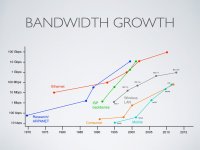In 2003, I created this chart:

And then in 2014 I updated it:

It's again 11 years later, so time to do an update!
But I'm having a hard time deciding what I should put in for Wi-Fi. Before 802.11n things were pretty simple: there was a maximum transmission rate that you would obviously never reach exactly, but could get pretty close to in optimal circumstances. But then we got MIMO (sending multiple data streams at the same time over the same channel using multiple antennas). So now the number of antennas and radios factors into the equation. And how many channels you are using at the same time. Originally those were 20 MHz, but these days you can go as high as 160 MHz, so combining 8 channels.
Now obviously very few devices are going to have 8 antennas. So what's a reasonable number for the max bandwidth that a somewhat powerful device such as a laptop could reach for a given Wi-Fi generation. These are now the names for those:
My 2013 and 2016 MBPs both do Wi-Fi 5 with 144 Mbps on 2.4 GHz, indicating 20 MHz and 2 antennas, but 1300 Mbps on 5 GHz, so that's 80 MHz channels and 3 antennas. My 2018 Apple TV 4K does 867 Mbps on 5 GHz so that looks like 80 MHz channels and 2 antennas.
I'm assuming my Wi-Fi 6 2023 Apple TV 4K still has two antennas but my home router reports "1 Gbps", which indicates anything over 999 Mbps. Same thing for my iPhone SE 3G.
My 2023 Raspberry Pi 400 does Wi-Fi 5 apparently with one antenna with 433 Mbps on 5 GHz.
But I also have a bunch of devices from well beyond 2013 when Wi-Fi 5 arrived that still only do Wi-Fi 4. For instance, my Brother laser printer that I got last year. And some devices that will only do 2.4 GHz, such as my Nikon Z fc (although that seems to be a European restriction) or my 2018 Sony blu-ray player. Also generally smart home stuff.
Fortunately, anything older than Wi-Fi 4 seems to have died out by now.
So finally getting to my question:
What kinds of link speeds are you guys seeing with newer laptops that support Wi-Fi 6 or 7?

And then in 2014 I updated it:

It's again 11 years later, so time to do an update!
But I'm having a hard time deciding what I should put in for Wi-Fi. Before 802.11n things were pretty simple: there was a maximum transmission rate that you would obviously never reach exactly, but could get pretty close to in optimal circumstances. But then we got MIMO (sending multiple data streams at the same time over the same channel using multiple antennas). So now the number of antennas and radios factors into the equation. And how many channels you are using at the same time. Originally those were 20 MHz, but these days you can go as high as 160 MHz, so combining 8 channels.
Now obviously very few devices are going to have 8 antennas. So what's a reasonable number for the max bandwidth that a somewhat powerful device such as a laptop could reach for a given Wi-Fi generation. These are now the names for those:
- Legacy (1997), 802.11 (2 Mbps @ 2.4 GHz)
- Wi-Fi 1 (1999), 802.11b (11 Mbps @ 2.4 GHz)
- Wi-Fi 2 (1999), 802.11a (54 Mbps @ 5 GHz)
- Wi-Fi 3 (2003), 802.11g (54 Mbps @ 2.4 GHz)
- Wi-Fi 4 (2009) 802.11n (2.4 and 5 GHz)
- Wi-Fi 5 (2013) 802.11ac (5 GHz)
- Wi-Fi 6 (2021) 802.11ax (2.4, 5 and 6 GHz)
- Wi-Fi 7 (2024) 802.11be (2.4, 5 and 6 GHz)
My 2013 and 2016 MBPs both do Wi-Fi 5 with 144 Mbps on 2.4 GHz, indicating 20 MHz and 2 antennas, but 1300 Mbps on 5 GHz, so that's 80 MHz channels and 3 antennas. My 2018 Apple TV 4K does 867 Mbps on 5 GHz so that looks like 80 MHz channels and 2 antennas.
I'm assuming my Wi-Fi 6 2023 Apple TV 4K still has two antennas but my home router reports "1 Gbps", which indicates anything over 999 Mbps. Same thing for my iPhone SE 3G.
My 2023 Raspberry Pi 400 does Wi-Fi 5 apparently with one antenna with 433 Mbps on 5 GHz.
But I also have a bunch of devices from well beyond 2013 when Wi-Fi 5 arrived that still only do Wi-Fi 4. For instance, my Brother laser printer that I got last year. And some devices that will only do 2.4 GHz, such as my Nikon Z fc (although that seems to be a European restriction) or my 2018 Sony blu-ray player. Also generally smart home stuff.
Fortunately, anything older than Wi-Fi 4 seems to have died out by now.
So finally getting to my question:
What kinds of link speeds are you guys seeing with newer laptops that support Wi-Fi 6 or 7?

